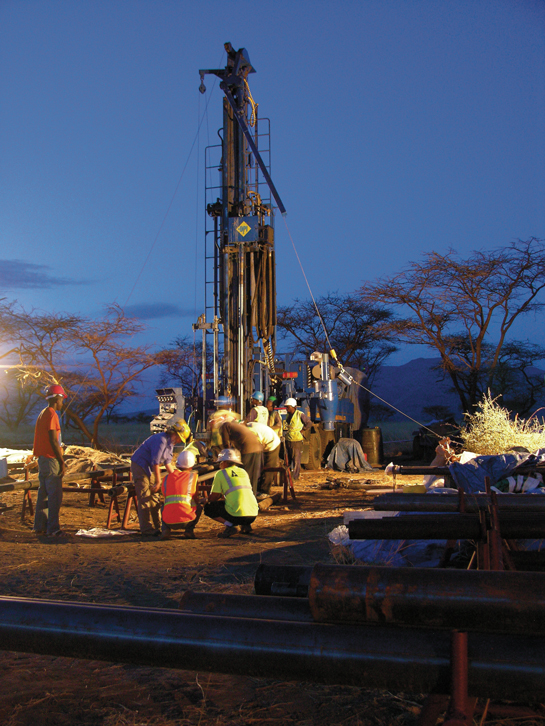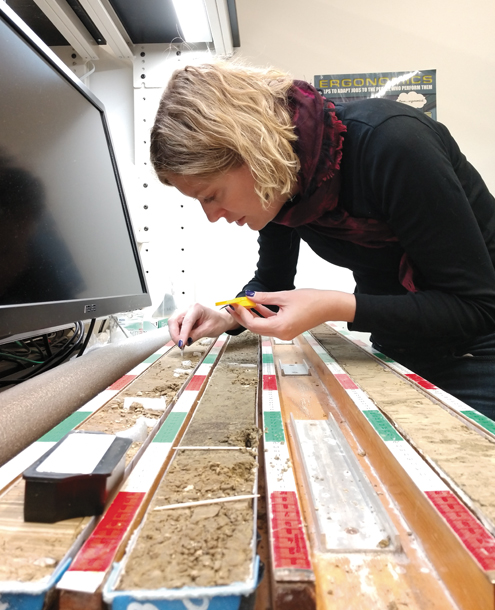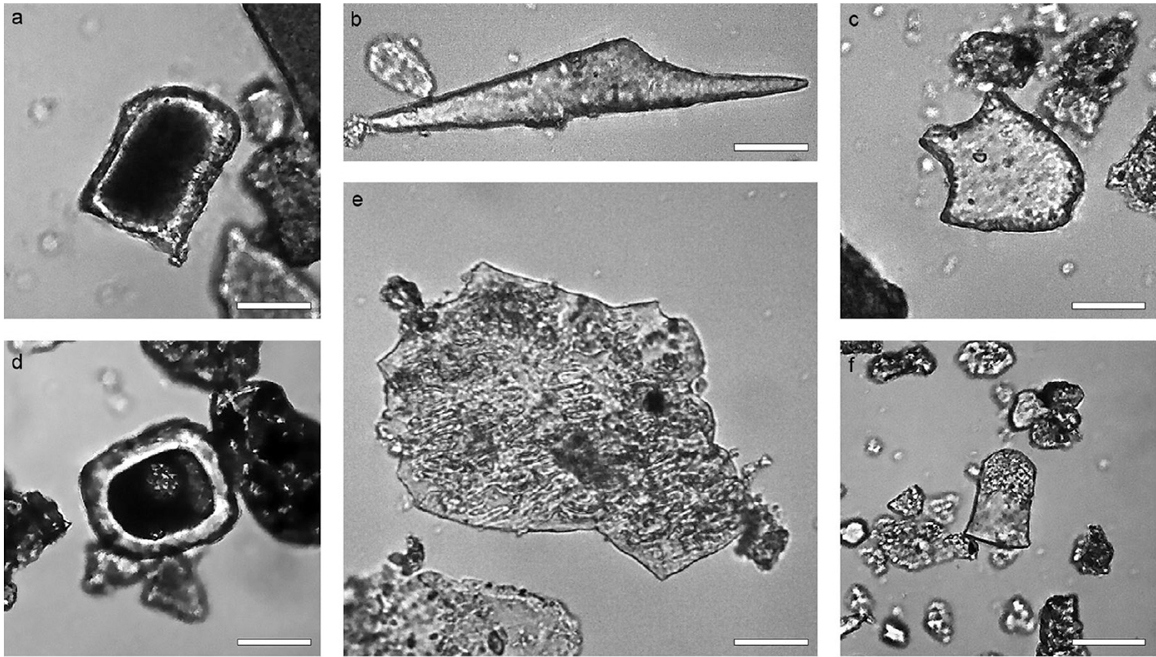Drilling into the Climate of Human Origins
By Sandra J. Ackerman
Cores of sediment from ancient basins and lake beds in eastern Africa reveal the fluctuating conditions under which our species evolved.
Cores of sediment from ancient basins and lake beds in eastern Africa reveal the fluctuating conditions under which our species evolved.

For the past couple of million years, the area of eastern Africa around the equator has been a particularly hospitable neighborhood for our genus, judging by how rich it is in early human fossils and artifacts. No fewer than five varieties of early Homo have been identified in this region, which includes portions of Ethiopia, Uganda, Kenya, and Tanzania. How did one relatively small spot nurture such variety, and why did half a dozen species dwindle down to the single one, Homo sapiens, that survives today?
According to a growing scientific consensus, a large part of the answer to both questions can be found in the climates of the past. A great many clues about past climates, and about when and how much they changed, reside in the sediment that lies beneath fossil-rich areas. The search for evidence of this variability leads, then, to sediment cores from eastern Africa—particularly from basins and lake beds, whose sediments are now yielding detailed records of climate history.

Photo by Jennifer Clark, Human Origins Program, NMNH, Smithsonian Institution
Core drilling for the purposes of scientific research first took place on the high seas, in efforts to test the theory of plate tectonics; the slow sedimentation rates of the seabed allowed paleoceanographers to assemble records spanning many tens of millions of years, albeit at low resolution. By contrast, research into human evolution calls for drilling onshore in the basins of ancient or extant lakes, where the rapid buildup of sediment can yield records that are typically shorter but offer a much finer time resolution of past African climate changes.
A period of particular interest for scholars of human evolution is the interval from about 500,000 to about 300,000 years ago, when the archaeological record shows large, heavy stone tools being replaced by a variety of smaller, more deftly fashioned tools for cutting, scraping, and other specific purposes. The Olorgesailie Basin in Kenya is world famous for its trove of fossils and for artifacts documenting this transition to more complex behavior—including the earliest known use of ochre as a pigment and the carrying of obsidian (volcanic glass) over long distances from its source to other sites where it was worked into tools and put to use. Sometimes stones were knapped or flaked into tools at one site, and then carried elsewhere to be used for butchering. Unfortunately, severe erosion of the Olorgesailie outcrop has left a gap in the fossil and archaeological record at just this interval, so that researchers up to now have had scant evidence of specific factors in the environment that may have driven these profound changes of behavior.
Many clues about past climates, and about when and how they changed, reside in the sediment that lies beneath fossil-rich areas.
Now available to help fill the gap, however, is a sediment core drilled from the neighboring Koora Basin, an ancient lake bed just 24 kilometers from Olorgesailie. Andrew Cohen, professor of geosciences at the University of Arizona, explains, “The point of drilling [here] is to capture the interval of time missing in the outcrop record. The core site at Koora is from an area in the central part of the basin where sedimentation was much more continuous during the time that erosion was occurring in the Olorgesailie outcrop area.”
In a new article in the Journal of Human Evolution (August 2021), paleoclimatologist Rachel Lupien and her colleagues combine several studies of the Koora Basin sediment core to produce a high-resolution record of environmental fluctuations in eastern Africa over the past one million years. Richard Potts, director of the Human Origins Program at the Smithsonian Institution’s National Museum of Natural History, oversees the drilling project and last year published the first results with his collaborators (Science Advances, October 2020).
The unusually high resolution of the Koora Basin record relies on three distinct components found in sediment cores: plant waxes, bulk organic matter, and phytoliths. The three different components show good alignment in their chronology (within a few millennia of one another), but each component yields information about a different spatial scale. “The three aren’t all giving us exactly the same information, but they give information that’s very closely linked,” Lupien says.
Plant waxes offer information on what was growing on land in the Koora Basin (and, by inference, the neighboring Olorgesailie Basin) at a given time. Composed of carbon and hydrogen, these compounds evolved early in the history of vegetation to protect soft tissues and reduce the evaporation of water from leaf surfaces. Plant waxes are lightweight and easily carried by wind throughout a large area. Under isotopic analysis, they can indicate the photosynthetic pathways of numerous plants, giving the general ratio of carbon-3 plants (trees and shrubs) and carbon-4 plants (mainly grasses) that were growing within the basin, and hence the types of vegetation that were available for early humans and other animals to eat.

Photo by Jennifer Clark, Human Origins Program, NMNH, Smithsonian Institution
Bulk organic matter incorporates material from both land and lake—Lupien likens it to a “soup of all the organic matter”—and therefore gives a record of past vegetation that is somewhat more broad than the detailed information from plant waxes or phytoliths. Recently, however, a new technique of analyzing so-called “clumped isotopes” from samples of calcium carbonates from ancient soils has begun to yield information about another important aspect of climate: temperature. Geochemist Emily Beverly, of the University of Houston, explains that in calcium carbonate, different isotopes of carbon and oxygen “clump” together in a way that depends on the ambient temperature. By measuring how frequently the rarer and heavier isotopes, carbon-13 and oxygen-18, bond in these carbonates, as compared with how frequently they would be expected to bond by random chance, researchers can get an idea of how hot or cool the atmosphere would have been in a given millennium—a useful level of resolution in a climate record spanning a million years.
The phytolith samples, the third component studied, give information only about plants that were growing within the basin itself. First recognized by Charles Darwin, who termed them “plant stones,” phytoliths are microscopic structures composed of silica that growing plants take up from the soil and deposit into and around their cells. (See “Phytoliths: The Storytelling Stones Inside Plants,” March–April 2015, for more.) Paleoecologist Rahab Kinyanjui, senior research scientist at the National Museums of Kenya, explains that because these “cell casts” are inorganic, they preserve their form and structure for many thousands of years, whether in dry or moist environments. In a laboratory setting, researchers can extract phytoliths from sediment and classify them according to taxa, and sometimes even to family, by their characteristic features. Within the grass family, phytoliths can indicate whether a plant used a carbon-3 or carbon-4 photosynthetic pathway; the presence of abundant carbon-3 plants would indicate relatively cool, moist conditions, whereas carbon-4 plants would prevail at times of greater heat and aridity.

Images courtesy of J. Mercader, et al. 2021. Phytolith palaeoenvironments at Mumba Rock Shelter. Frontiers in Ecology and Evolution 9:699609.
Although the analyses of plant waxes, bulk organic matter, and phytoliths each reveal different aspects of the paleoenvironment, they all tell the same story: recurring cycles of great variability in the climate of eastern Africa between about 400,000 and 90,000 years ago. As James Russell, chair of Brown University’s Department of Earth, Environmental, and Planetary Sciences, says, “The fact that all these data show very similar patterns lets us focus on the environmental history of the area.”
A major driver of environmental history in this region is the nature of the monsoons, which produce a twice-yearly onslaught of wind and rain that can account for up to 75 percent of annual rainfall. Extensive research has shown that Earth’s rotation is subject to a rocking motion, known as precession, like the wobble of a spinning top, which can alter the length and strength of the monsoons. “There will always be a rainy season and a dry season,” says Lupien, “but the length and intensity of monsoons, and in turn the timing and intensity of rainfall in a given year, will vary because of precession.” At 21,000 years in length, cycles of precession appear to account very well for the environmental variability that shows up in the records of plant waxes, bulk organic matter, and phytoliths.
Precession is not the only orbital pattern to make its mark on the climate. In a longer cycle, about every 400,000 years, precession becomes much stronger, according to Mark Maslin, paleoclimatologist at University College London. With a great increase of rainfall from strengthened monsoons, freshwater lakes would suddenly appear, only to dry up and disappear again over the course of the next few thousand years. In any case, says Maslin, “I’m not convinced we can trace the story of human evolution in Africa by focusing on a small number of sites” such as Olorgesailie. In studying four million years of climate records with his collaborators, Maslin says, “We found you could see changes in the whole of eastern Africa, and even throughout the continent.”
Crucially, the climate fluctuations that researchers have teased out thus far all appear to have acted in different time frames, on many distinct but interrelated aspects of the environment. Equally important, the fluctuations cannot all be traced to a single cause. The formula of attributing human evolution mainly to various ice ages is one that Maslin dismisses as a “zombie idea,” repeatedly and deservedly put down, only to rise again. “We must look at the fossils, the geological records, the astronomical data, the history of the ocean basins, and the paleoclimate all together,” he insists. “It is variability of the climate that drives human evolution. Variability allows for the proliferation of species, but it also leads to higher population densities, and hence to competition.”
In view of the wealth of information they can uncover, drilling rigs will likely soon be added to the toolkit of many archaeological excavations that take place on the shores of ancient or extant lakes. After all, says the Woods Hole Oceanographic Institute director Peter de Menocal, “It’s these lake sediments that really tell the story of changes in the climate, right next to where the fossils are found.”
Click "American Scientist" to access home page
American Scientist Comments and Discussion
To discuss our articles or comment on them, please share them and tag American Scientist on social media platforms. Here are links to our profiles on Twitter, Facebook, and LinkedIn.
If we re-share your post, we will moderate comments/discussion following our comments policy.